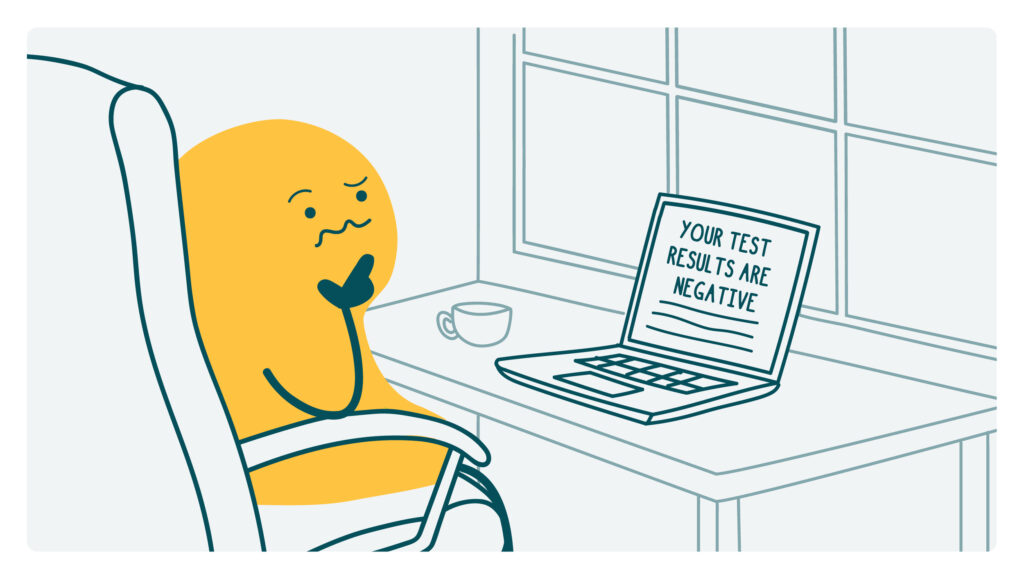
Picture this all-too-common scenario: Your doctor orders some routine blood tests at your annual checkup. So, you pop down to the lab, roll up your sleeve, and forget all about it… until a day or so later, when you get an alert from your patient portal. You log in and promptly start to panic. Oh no! Your XYZ is too low! Your ZYX is too high! You are clearly dying!!!
You call up your doctor. Why didn’t they notice at your appointment that you were mere moments from death, as these test results reveal? Pish posh, the doctor says. Tut tut. We don’t worry about XYZ results until it’s much lower than that. And that ZYX test — why that could’ve been thrown off by an overly large breakfast. Everything is completely fine!
Thanks to a 2016 law called the 21st Century Cures Act, patients now have immediate, unfettered access to their own health information. And that can be a good thing! But it also means people can get some pretty alarming info in their inboxes, sometimes before their own doctor has seen it.
For example, imagine that the results in your portal show that you may have cancer or another life-altering illness. And they arrive at 5 p.m. on a Friday, just as the doctor’s office closes. That’s a recipe for one very sleepless weekend. So, how can health communicators help doctors and patients navigate this situation?
Try these tips the next time you create materials about test results.
Explain the reference range. We’ve written before about a better way to communicate positive and negative test results. For results that use a reference (or “normal”) range, explain that labs set the range based on results for a group of healthy people. But they don’t capture the full range of possible results. So, the key thing to remember is that being outside the range doesn’t always mean you’re sick, and being inside the range doesn’t always mean you’re healthy. The best way to understand results is to talk directly with the doctor who ordered the test.
Provide a guide to complicated results. If you’ve ever read a pathology report, perhaps you’ve been offended by a reference to your insides called a “gross description.” Patients might be relieved to know that the pathologist is not, in fact, disgusted by their innards — this just means a general description of the tissue sample before they put it under a microscope. So, when the results go beyond a number on a range, provide a guide to what the results will look like and explain key terms patients need to understand.
Encourage doctors to set clear expectations. Before any blood gets drawn or samples taken, the patient should understand the purpose — and limitations — of the test. Will the result give a clear diagnosis? Is it just the first step to rule something out on the way to an answer? What’s the chance of a false result? How long will the results take, and how will the doctor follow up? This kind of level-setting is especially important when testing for a serious or sensitive illness, like cancer or a sexually transmitted infection.
Share some self-advocacy scripts. Even the best health education materials are no substitute for a clear conversation between doctor and patient. And doctors are often ordering tests in a hurry. So help support patients in getting the information they need by sharing these scripts.
- “Do I need to prepare before the test?” Some tests require fasting for a certain amount of time, but that’s not the only thing that can affect results. Encourage patients to ask if they need to change their routine leading up to the test — and to make sure their doctor knows all the medicines, vitamins, and supplements they’re taking.
- “What’s a normal result for me?” Labs often use different ranges based on things like age, sex, and pregnancy status. But lots of other factors like health conditions, activity level, and even geographic location can affect what’s “normal” for a specific person. So, encourage patients to ask their doctor what’s normal and healthy for them. That way, they’ll know what to expect before they see a result marked too high or too low.
- “When will you contact me about the results?” Doctors can’t always contact patients before results appear online. But patients can make a plan with their doctor for how they prefer to receive the results. For example, a doctor might agree to call or send a message within 2 days after the results arrive. That way, patients can decide if they want to look at the results on their own or wait to speak with their doctor directly.
The bottom line: Test results can be confusing, so explain what to expect from different tests — and encourage doctors and patients to have a conversation before heading off to the lab.
Copy/paste to share on social (and tag us!): How can we support patients in the era of instant online test results? CommunicateHealth offers some tips: https://communicatehealth.com/wehearthealthliteracy/tips-for-talking-about-test-results #HealthCommunication #HealthLiteracy #HealthComm
Browse recent posts